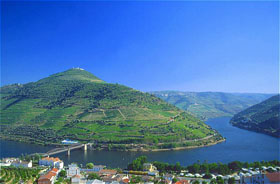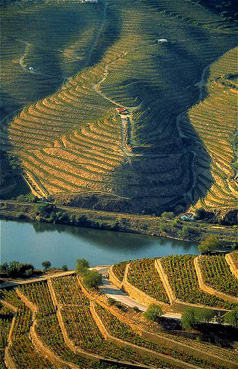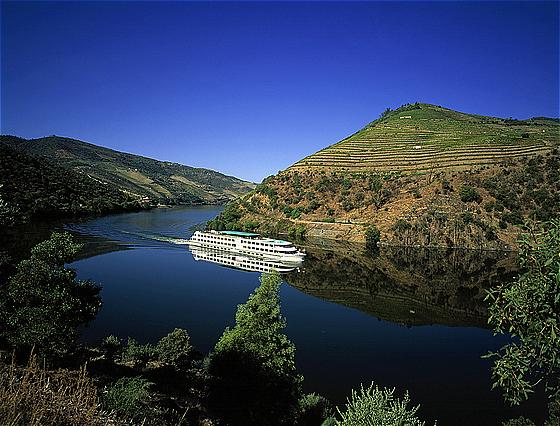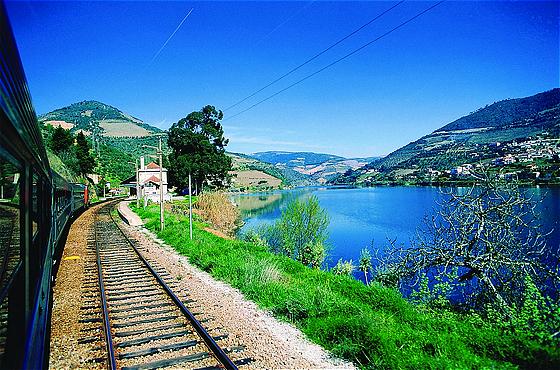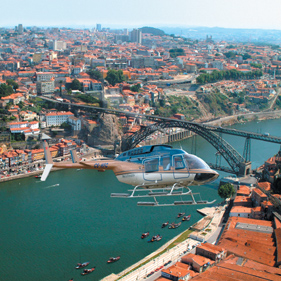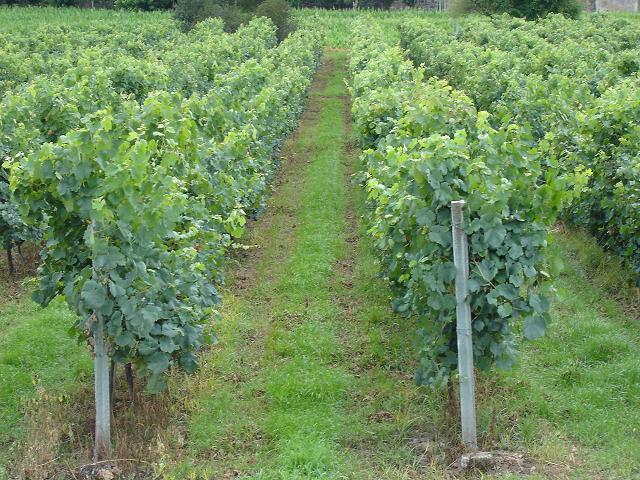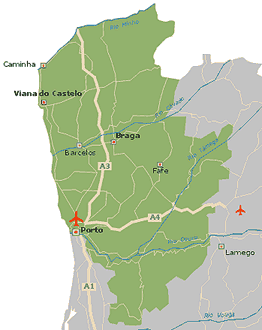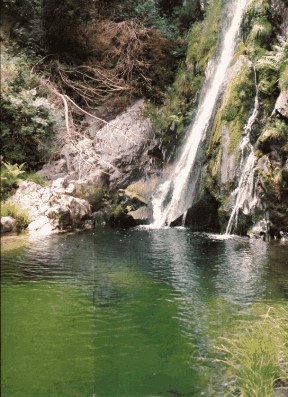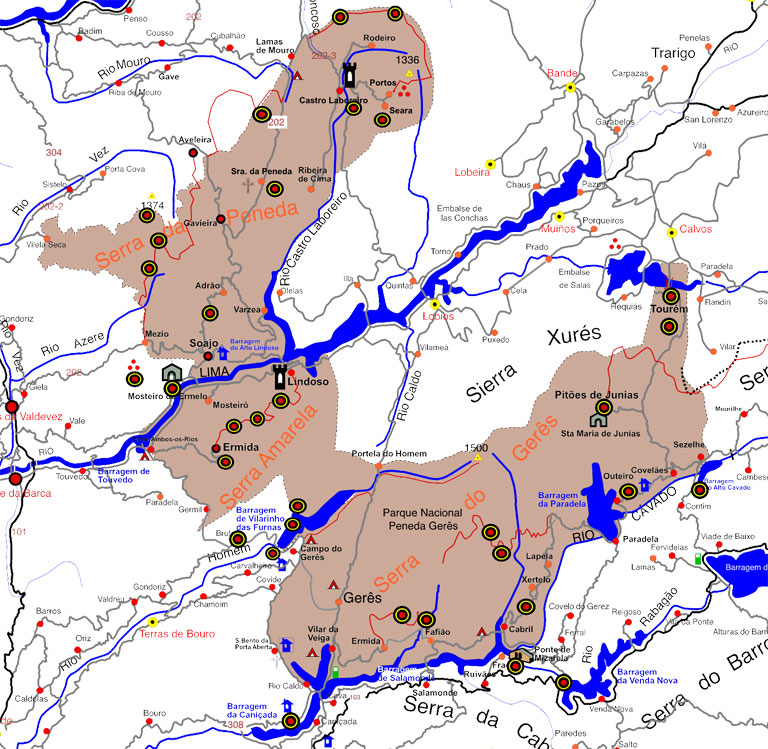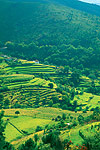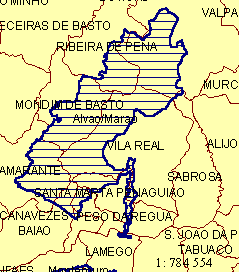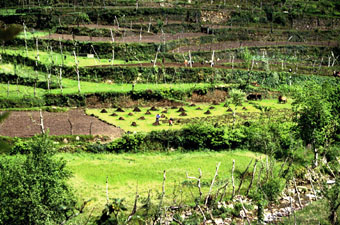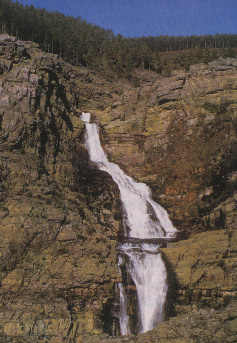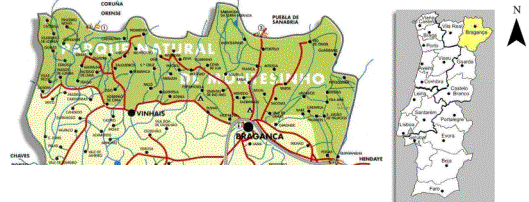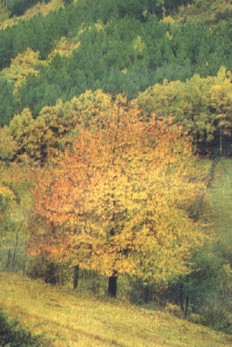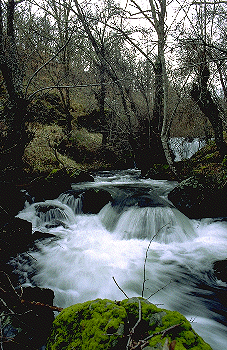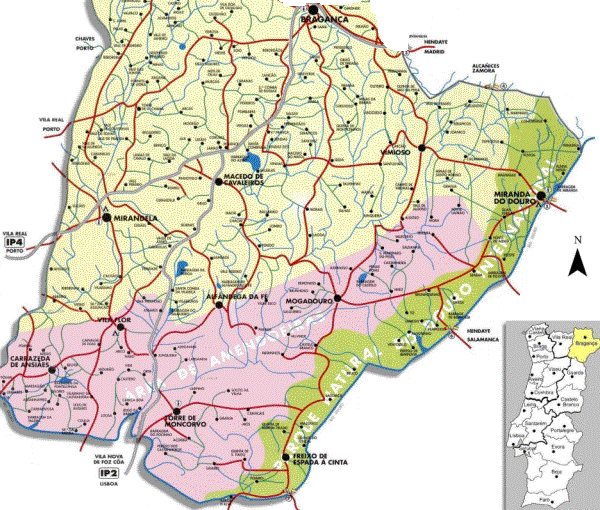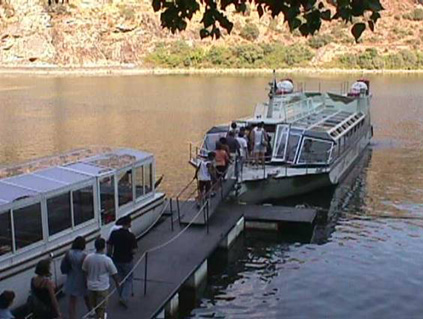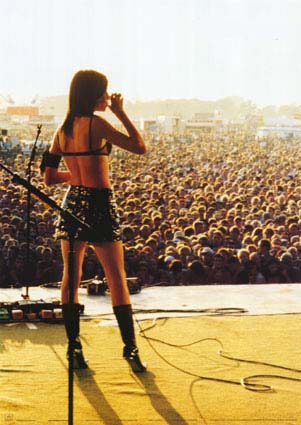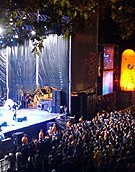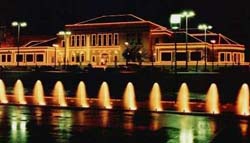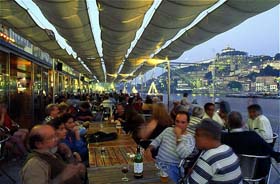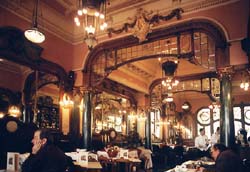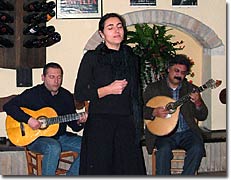 |

|
 |
|
|
| FLASH. |
|
topÎ
The River Douro rises in Spain and flows more or less East - West across Northern Portugal reaching the sea at Portugal's second city, Porto. Once a fast flowing river of rapids and narrow ravines it has been tamed over the past 25 years by the construction of 8 dams along its length giving it, in most places, a tranquil, lake-like appearance. .
The valley is spectacularly beautiful with the hills falling steeply down to the water's edge becoming more and more sparsely populated and wild the further inland one travels, with more of the land being given over to terraces of vines and, to a lesser extent, olive groves. This is port country and was, in fact, the world´s first demarcated wine region being established in 1756. Evidence of the port industry can be seen along the valley with all the famous company names - Cockburns, Taylors, Sandeman and others - appearing on large placards on the hillsides. The colour of the land changes throughout the year as the vines mature. February and March though also sees the almond trees in blossom, particularly in the upper reaches, creating blankets of pink-white everywhere which, with fine weather, brings the Portuguese out for the first picnics of the year. Generally, though, there is little in the way of developed tourism, visitors are comparatively few and, as far as crowds are concerned, getting around is fairly easy. However, the roads zigzagging up and down the mountainsides and between the tributary valleys can be difficult driving but it does offer fantastic unspoilt scenery. More relaxing modes of transport are available, however.
Undulating landscapes of vines, attractive, peaceful towns and castles from the times of the Christian Reconquest are all part of your drive through the Douro Valley. Follow the main road, beginning in Peso da Régua and driving across the plateaux above the Douro valley. From the viewpoint of São Leonardo, you can see the river valley and the mountains of the Serra do Marão, all in just one glance. A famous Portuguese writer described this landscape as a "geological poem". You'll easily understand why. At Casal de Loivos, you have a naturally formed balcony overlooking Pinhão and the open, curved valley of the River Douro. Rest for the night in a manor-house and wake up gently to the surprising and beautiful view. Cross over the River Tua, a tributary of the Douro, visit Torre de Moncorvo and continue on to a very special part of the Douro, Barca d'Alva. One of the best Portuguese wines is produced here. Very close by is the Foz Coa Archaeological Park, a fascinating outdoor gallery of rock art, which has been classified as world heritage.
You have almost reached the far end of Portugal. Whenever you can, let yourself get lost along the minor roads, and, on your way back, following the southern bank of the River Douro, make sure to stop and enjoy the views from the castle of Numão and São Salvador do Mundo. These are places from where it is well worth gazing at the horizon.
The Douro by helicopter Enjoy a bird's eye view of the Douro Valley in a helicopter.
Starting in Porto, a great way of exploring the Douro is to fly over the river in a Bell Long Ranger helicopter. You can take four friends with you on this journey to the heart of the Alto Douro region. The scheduled trip takes you to Mesão Frio, where a delicious lunch awaits you at the Solar da Rede. This typical Douro estate produces vintage Port plus an excellent table wine (Douro wine). Over lunch, you'll have the chance to taste examples of the region's traditional cuisine. The recipes are all based on the estate's fresh farm produce. If you come here at the end of the summer, you'll be able to join in the grape harvest, a time for hard work but also of great fun. You can also plan your own trip or take some shorter helicopter rides. Choose one of the brief journeys to the Crestuma dam or fly over Porto with its six bridges and its famous city centre.
Explore the Minho region and discover the unique Vinho Verde(green wine) wine.
A light and refreshing wine, Vinho Verde is found nowhere else in the world. It goes well with fish and shellfish and is perfect on a hot day. The region of Minho is in northern Portugal. The grape vines climb trellises on the hilly terrain near fields scattered with traditional espigueiros (grain stores). Granite mansions and historical buildings rise out of the green countryside and are well worth visiting. Start on the coast, in Caminha and Vila Nova de Cerveira. On the banks of the River Minho, you'll find the pretty town of Valença. Further north, the towns of Monção and Melgaço are the main producers of one of the most famous types of Vinho Verde, Alvarinho. Not far away is the Peneda-Gerês Park, with mountain villages full of history, like Castro Laboreiro and Soajo.
Arcos de Valdevez, Ponte da Barca and Ponte de Lima owe their names to the rivers that make them attractive and cool, like Viana do Castelo, at the mouth of the River Lima. Visit Barcelos, on the River Cávado, and Braga, with its traditional regional heritage. And why not take a trip to the ancient town of Guimarães, a World Heritage site, then see the sights at Amarante, another historic riverside town? Don't leave without visiting the region's most well known estates, equally famous for their stately homes as the quality of their wines.
Man and nature makes all around this region the perfect symbioses. Over centuries man as sculpted nature imperfect features, transform them into a splendorous landscape. Reconnect with mother earth and experience all the natural beauty of the parks of the Minho and Trás-os-Montes.
The Peneda-Gerês National Park is a natural jewel of outstanding beauty. Come and discover these wonderful natural surroundings and unique species including wild ponies, golden eagles and the Castro Laboreiro dog breed. Discover the local traditions and customs in the villages Lindoso and Soajo. Visit their castles for breathtaking views out over the hills Man and Nature have achieved a fine, harmonious balance in the Montesinho, Alvão and Douro International Natural Parks. They include village communities that have done much to retain the traditions of rural life. There is a range of itineraries to help you structure your visit. The dams and reservoirs provide further leisure and recreational opportunities. Canoeing, bicycle and horse riding or hill walking are all excellent means of exploring while relaxing. Be sure to keep the bathing costume handy. There are many rivers and streams to be discovered on your journey and some great spots for swimming in the natural freshness of these waters.Discover the thin golden sand beaches where a variety of sports can be practised.
The Peneda-Gerês National Park is a natural jewel of outstanding beauty. Come and discover these wonderful natural surroundings and unique species including wild ponies, golden eagles and the Castro Laboreiro dog breed. Discover the local traditions and customs in the villages Lindoso and Soajo. Visit their castles for breathtaking views out over the hills. Man and Nature have achieved a fine, harmonious balance in the Montesinho, Alvão and Douro International Natural Parks. They include village communities that have done much to retain the traditions of rural life. There is a range of itineraries to help you structure your visit.
In Alvão, among the spectacular geological formations and the harmony of the natural ecosystems, daily routines lose much of their significance and the return to Nature takes on a spontaneous appeal.
In this natural park, which essentially occupies the western slope of the Alvão Mountain, the geology is the major conditioning factor in the natural landscape. In all the upper zone, which includes Lamas de Olo and Arnal, the profusion of large granite blocks makes the landscape harsh and angular. The Basal Zone, with its narrow enclosed valleys (Varzigueto, Fervenca and Ermelo) is characterised by schists and by the presence of an abrupt change of altitude, which gives rise to the spectacular Fisgas waterfalls.
The fauna is also exceptional in the Alvao Natural Park because of its diversity and abundance. Amphibians and reptiles are found widely and the birds, particularly birds of prey like the round winged eagle, and smaller birds like the titmouse or the "Estrelinha de cabeca listada" (striped headed star) choose this as a favoured location.
The mammals are mostly small, such as the field mouse or the rabbit and these make up the park's fauna, although it should be mentioned that the wolf occasionally appears in this protected area. Ermelo and Lamas de Olo are today considered the most suitable places to visit and find the best examples of popular architecture in the region. Despite the introduction of new standards and technology that has lead. to the replacement of many traditional materials (granite and thatch) with more modern ones, it is still easy to come across small neighbourhoods where granite and schist are dominant. The most interesting walks can also be organised in the area around these two villages.
Situated in Trás-os-Montes (beyond the mountains) , in the region of Montanhas to the north east of Portugal and with the Spanish mountains as neighbours, Montesinho is a fantastic mixture of natural resources and very old, cultural heritages. The mountains carry on as far as the eye can see, into Spain. Unexpectedly, there are coloured birds and melodious bird songs that it is almost impossible to hear in less hidden places. At a distance, against the blue of the sky, you can follow the sinuous flight of a royal eagle. At the crossing of the pathways it is easy to detect the footprints of wolves and foxes, deer droppings and to see where the wild boar has passed.
The immense forests of black oak are one of the region's main riches, which living in harmony with the sweet chestnuts, the symbol of the natural park, contribute to the balance of the forest. On the rocky slopes there is an abundance of white birch, heather and broom, whilst on the banks of the rivers there are alders, willows, hazels and poplars. The isolation provided by the mountains gave rise to the development of unique cultural forms. The ‘Rionorês' dialect itself, spoken by those living along the River Onor and Guadramil, the community forges and ovens, the cattle herding and the neighbourhood counsels are living examples of the well rooted social and community traditions.
Douro International Natural Park
The INTERNATIONAL DOURO NATURAL PARK is known by its impressive slopes that magnificently touch the sky, showing us the smallness of Humankind towards the power of Nature. It lodges one of the rarest and richest fauna communities of the world. Participating in an unique experience, share with us an unforgettable cruise in the river (with dinner served on board included) during which you may have the chance to see the Royal Eagle, the Griffon or the Black Vulture.
People on northern Portugal have a very long tradition on religious festivities; mainly in spring/summer season, each city or village are really engaged to show their best, trying to demonstrated that is own festivity is better than neighbour's festivity. It's a dramatic, but enrich competition experience, which outside visitors really appreciated. Also music festivals take place all over the region: International Classic Summer festival of Póvoa de Varzim, Paredes de Coura rock festival or Vilar de Mouros rock festivals are just a few examples of what can be seen on this region. On the other hand , the Casino of Póvoa de Varzim provide its daily international quality show on attractive ambiance style. Really not to be missed! National entertainment In general, you'll fare better if you keep in mind that Portugal is not a brash, booming country with a lot of wild, gaudy entertainments, like the countries in northern Europe. It is a country with a heavy patina of history and sophistication. If you want to be entertained in the best Portuguese style, you'll have to take the trouble to enter into the heart of Portugal and learn to appreciate, for example, the very special decor of the Café Majestic in Porto. Gambling is a big entertainment in Portugal. You are sure to go to a casino at least once while you are here, if only to watch, though you can hardly appreciate the sights without taking part to some small extent. The casinos charge an entrance fee, and you'll need to have your passport checked at the entrance. The games played at most of the casinos include roulette, French Bank, Bacará (Chemin‑de‑Fer), Black Jack (" 21 "), craps and chuck luck. If you plan to go in for this entertainment in a big way, get hold of a book of rules and bone up before your trip. Casinos usually are in large buildings including a gaming room, a room for slot machines, an art gallery, a night club, with perhaps a cinema and shops as well. The Casino of Póvoa provide daily(except monday/tuesday) Show and dinner, in an atmosphere of glamour and amusement,
Some resorts as Póvoa de Varzim, Matosinhos and Porto, are right up with the rest of Europe in the plush discotheque sort of entertainment. If after traveling through primitive farmland, studded with ancient castles, you begin to feel nostalgia for the twentieth century, it's in these resort towns that you'll find your way back. Back to the world of European playthings, their wide assortment of companions, American girls wearing mink coats over their bathing suits, along with their victims of the night, bored businessmen looking for that stray companion that is never to be found, and travel book writers taking it ali in. The cinema is very popular among the Portuguese. If you've been in Spain you'll be expecting large‑scale dubbing. Happily for you, however, the films are shown with their original sound tracks. As everywhere else, most of the films, especially on the popular level, are from America or England. You can find out what's playing by asking the concierge for the cinema page in the local paper, and while you're at it, have him book you a seat in advance, especially if it's on a weekend
The coffee served is a blend of the best in the world, a mixture of Brazilian and African beans served in small cups. Better use plenty of sugar, as it's quite strong. If it's not to your taste, you can also get tea that is fair to middling.
|
|||||||||||||||||||||||||||||||||||||||||||||||||||||||||||||||||||||
